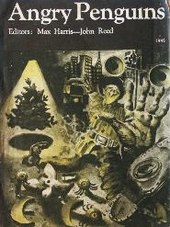|
Angry Penguins
 Angry Penguins was an art and literary journal founded in 1940 by surrealist poet Max Harris. Originally based in Adelaide, the journal moved to Melbourne in 1942 once Harris joined the Heide Circle, a group of modernist painters and writers who stayed at Heide, a property owned by art patrons John and Sunday Reed. Angry Penguins subsequently became associated with, and stimulated, an art movement now known by the same name. The Angry Penguins sought to introduce avant-garde ideas into Australian art and literature, and position Australia within a broader international modernism. Key figures of the movement include Sidney Nolan, Arthur Boyd, Joy Hester and Albert Tucker. In 1944, Angry Penguins became the subject of a famous literary hoax perpetrated by anti-modernist poets James McAuley and Harold Stewart. The journal ceased publication two years later. Origins and ethosThe precursor to the Angry Penguins magazine, Phoenix, was published at the University of Adelaide with funds from the University Union. Funding was withdrawn in 1940 following a change in leadership. Phoenix was no longer published, but carried on as Angry Penguins under the Arts Association, with funding from J. I. M. Stewart and Charles Jury, and others.[1][2] Angry Penguins was first published in the South Australian capital of Adelaide. The title is derived from a phrase in Harris' poem "Mithridatum of Despair": "as drunks, the angry penguins of the night", and its use as a magazine title was suggested to Harris by C. R. Jury.[3] In 1942, Harris gained the patronage of John and Sunday Reed in Melbourne, and the magazine subsequently moved to the couple's home at Heide (now the Heide Museum of Modern Art). Through Angry Penguins, Harris and various contributors promoted modernism in Australian art and literature, challenging traditional and conservative cultural norms. They embraced experimental and innovative approaches in poetry, painting, and other forms of artistic expression. The Angry Penguins artists were early Australian exponents of surrealism and expressionism, and included John Perceval, Guy Gray Smith, Arthur Boyd, Sidney Nolan, Danila Vassilieff, Albert Tucker and Joy Hester. The journal attracted criticism from different factions of the Australian art and literary worlds. Its main Adelaide rivals were the nationalist and anti-modernist Jindyworobaks, whose poetry drew on Indigenous Australian culture and the Australian bush ballad tradition. According to Angry Penguins poet Geoffrey Dutton, "we stayed with Yeats, Eliot and Auden, ... and left Lawson and Paterson to the Jindys."[4] The Communist Party of Australia and associated social realist painters also publicly criticised Angry Penguins. In the August 1944 issue of the Communist Review, to support his assertion that the journal "has nothing to offer to Australian art, and that its effect will be to destroy, not raise Australian standards",[5] Vic O'Connor wrote that editors of cultural publications are responsible for fostering cultural development as a part of the overall advancement of "standards of social and economic life in Australia", and that the editors of Angry Penguins are "completely indifferent" to this".[5] Ern Malley hoax Angry Penguins found detractors in poets James McAuley and Harold Stewart, who, during their time at the Directorate of Research and Civil Affairs, created a series of poems constructed as a pastiche of nonsensically arranged fragments, and attributed them to a fictitious poet named Ern Malley. McAuley and Stewart then submitted the poems to Angry Penguins for publication, and in doing so sought to prove that modernist poetry has no inherent value.[7] The poems were received and published enthusiastically by the creators and patrons of Angry Penguins, who dedicated the 1944 autumn issue to Malley. When it was revealed to be a hoax, Angry Penguins received negative backlash, and the affair tarnished the image of the journal, which was subsequently tried and convicted for indecency on the grounds that the poems contained obscene content.[8] Legacy and influenceThe Angry Penguins art movement was surveyed in the 1988 exhibition Angry Penguins and Realist Painting in Melbourne in the 1940s, held at the Hayward Gallery in London.[9] In the exhibition's catalogue, English novelist C. P. Snow is quoted as saying that the Angry Penguins movement "was probably the last flowering of a 'national' modernism that a completely internationalised world of the arts was likely to see".[10] Cultural references
See also
References
External links
|